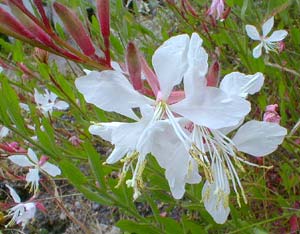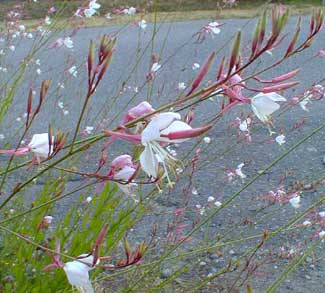 'Whirling Butterfly' Gaura,
'Whirling Butterfly' Gaura,
aka, White Indian Feather
"I thought to have laid down my hair before
Benignant Artemis, and not have dimmed
Her polished altar with my virgin blood;
I thought to have selected the white flowers
To please the nymphs, & to have asked of each
By name, and with no sorrowful regret."
-Walter Savage Landor
(1775-1864)
(1775-1864)
Our varieties of Gaura lindheimeri include the white-flowering 'Whirling Butterfly,' pink-flowering 'Siskiyou Pink,' variegated foliage, 'Sunny Butterflies,' & dwarf red-twigged 'Crimson Butterflies.'
Of the four varieties we have, 'Whirling Butterfly' is largest, & the most like the wild species in size & appearance. The foliage of the main clump stands a good three feet tall & fountains to four foot spread, but with many of the flower stems over six feet tall with six foot fountaining spread. It could get even bigger than that, but will become rangy if not occasionally trimmed back to retain compactness & induce reflowerings.
 'Whirling Buttefly' is close to ever-blooming & flowers strongly up to October with a few flowers occurring until deep into winter, then starting anew by late spring if not sooner.
'Whirling Buttefly' is close to ever-blooming & flowers strongly up to October with a few flowers occurring until deep into winter, then starting anew by late spring if not sooner.We planted this White Gaura, Butterfly Bush, or Indian Feather, in a low-maintanence sun-garden near the road, where it demands no attention beyond a very occasional watering in the rainless summer. To see actual white butterflies dancing in sunlight all about those butterfly-like white flowers can incite a moment's awe.
In our garden, 'Whirling Butterfly' blooms start in late May or early June (usually a week or two earlier than 'Siskayou Pink') & last through October or even later. It is at its height of flowering beauty July through September. It still gave us a few blooms in December but not enough to be at all showy, unlike the 'Siskiyou Pink' that is sometimes surprisingly flowery clear to year's end.
The white flowers, if you look closely, show a faint flush of pink, & the buds are very pink.
Like all gauras it is extremely long-lived, should not be transplanted after it has set down a taproot, makes excellent cut flowers, & is a favorite of pollinating insects.
These plants are low-maintenance & hardy, but to do them absolute justice, we top-coat the soil with composted steer manure or leaves that break down into leafmold for winter protection & because these top-coatings provide mild nutrients for the arrival of spring.
Though semi-evergreen through our winters, it's not all that attractive by winter's end. A hard prune by early spring, before new growth begins, should remove as much as half to two-thirds of the stems. If the ground hadn't been topcoated for winter, then it can be given a slow-release fertilizer at the same time it is pruned. A rich fertilizing does it no particular favor.
In mid to late summer it may seem to have stopped blooming quite so extremely well, at which time it can be pruned again if it looks like it needs it, or it can at least be deadheaded, & will immediately bush out & bloom anew for Autumn, as brilliantly as its first go.
Though it is often recommended to deadhead to extend bloom time, both our varieties have bloomed through October or later without deadheading beyond the occasional taking of cut flowers. So it's my impression that deadheading is not necessary to sustain long bloom times, though the whole plant gets rangy if never trimmed at all.